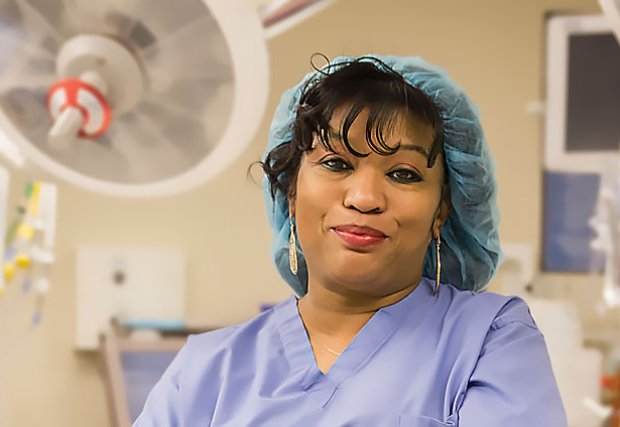Knowing the Signs of Possible Stroke Can Mean the Difference Between Life and Death
Michelle Jackson, a surgical technician at The George Washington University Hospital, was in the right place at the right time. On January 30th, she was working at the hospital and eating lunch when her speech started to slur. Knowing the symptoms of a possible stroke, Michelle’s colleagues determined that she needed immediate intervention.
They rushed Michelle to the catheterization lab, where doctors ran a CT scan and administered tPA, a medication that helps dissolve clots which are blocking blood flow. “I noticed results right away,” says Michelle. Neurosurgeon and Interventional Neuroradiologist Dimitri Sigounas, MD, says quick action and treatment within three hours of symptom onset is critical if someone is having a stroke. “The more time that passes without treatment, the more brain cells are lost,” he says.
As a Comprehensive Stroke Center (CSC), the goal is to have treatment initiated within 30 minutes of the patient’s arrival at the hospital. Dr. Sigounas says they are notified when a stroke patient is coming in, so the team has time to prepare and begin treatment right away. “Michelle was already here at the hospital, so her treatment was even quicker,” he says.
Michelle is grateful for her coworkers’ quick thinking and says they saved her life. “I had no brain damage, paralysis or vision loss. By the grace of God, I was in the right place at the right time,” she says.
Recognize These Signs of Stroke and Act FAST
- FACE: Ask the person to smile. Does one side of the face droop?
- ARMS:Ask the person to raise both arms. Does one arm drift downward?
- SPEECH: Ask the person to repeat a simple phrase. Is it slurred or strange?
- TIME: is critical! If you see any of these signs, call 9-1-1 immediately.
If these symptoms appear, DON’T WAIT! Call 9-1-1 or seek medical attention right away.
“Brain Attack LVO” Code Provides Faster Care for Stroke Patients
A stroke, also known as a “brain attack,” occurs when the blood flow to the brain is cut off. Stroke Nurse Navigator Mary Cres Rodrigazo, RN, says a new code, “Brain Attack LVO” (Large Vessel Occlusion) alerts the interventional radiology team to prepare for a patient who needs a clot removed from a large vessel of the brain. “As a Comprehensive Stroke Center, we recognize there are several types of strokes and they should be treated differently,” says Mary. “The quicker we can treat the patient, the less brain damage they sustain.”
Learn more about GW Hospital's Comprehensive Stroke Center

